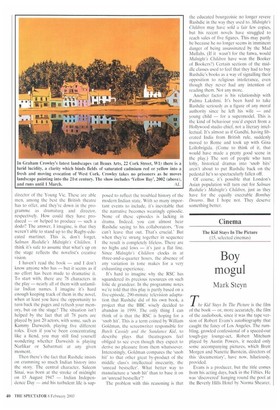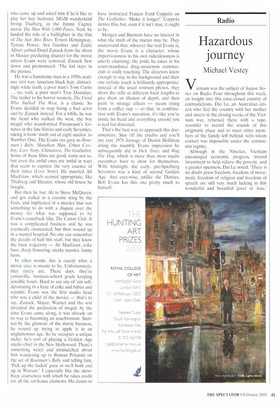The Kid Stays In The Picture (15, selected cinemas)
Boy mogul
Mark Steyn
The Kid Stays In The Picture is the film of the book — or, more accurately, the film of the audiobook, since it was the tape version of Robert Evans's autobiography that caught the fancy of Los Angeles. The rumbling, growled confessional of a spaced-out tough-guy lounge-act, Robert Mitchum played by Austin Powers, it needed only some accompanying pictures, which Brett Morgen and Nanette Burstein, directors of this 'documentary', have now, hilariously, provided.
Evans is a producer, but the title comes from his acting days, back in the Fifties. He was 'discovered' hanging round the pool at the Beverly Hills Hotel by Norma Shearer, who came up and asked him if he'd like to play her late husband, MGM wunderkind Irving Thalberg, in the Jimmy Cagney movie The Man With 1,000 Faces. Next, he landed the role of a bullfighter in the film of The Sun Also Rises. Ernest Hemingway, Tyrone Power, Ava Gardner and Eddie Albert cabled Daryl Zanuck from the shoot in Mexico predicting disaster for the movie unless Evans were removed. Zanuck flew down and pronounced: 'The kid stays in the picture.'
He was a handsome man in a 1950s matinee idol way: luxuriant black hair, distractingly white teeth, a poor man's Tony Curtis ... no, wait, a poor man's Troy Donahue. The trailer to his horror western, The Fiend Who Stalked The West, is a classic. So Evans decided to stop being a bad actor and be Zanuck instead. For a while, he was the fiend who stalked the west, the boy mogul who transformed Paramount's fortunes in the late Sixties and early Seventies, taking it from 'ninth out of eight studios' to Number One. The Evans era gave us Rosemary's Baby, Marathon Man, Urban Cowboy, Love Story, Chinatown, The Godfather. Some of these films are good, some not so, but even the awful ones are awful in ways that seem to capture the very essence of their times (Love Story). He married Ali MacGraw, which seemed appropriate, like Thalberg and Shearer, whose old house he bought.
But then he lost Ali to Steve McQueen. and got nailed in a cocaine sting by the Feds, and implicated in a murder that was something to do with a dispute over the money for what was supposed to be Evans's comeback film, The Cotton Club. It was a complicated business and he was eventually exonerated, but then wound up in a mental hospital. No one can remember the details of half this stuff, but they know the basic trajectory — Ali MacGraw, coke bust, shady financing, murky murder, funny farm.
In other words, this is exactly what a movie exec is meant to be. Unfortunately, they rarely are. These days, they're yawnsville, business-school grads keeping sensible hours. Hard to see any of 'em selfdetonating in a haze of coke and babes and scandal. Evans was the first studio head who was a child of the movies — that's to say, Zanuck, Mayer, Warner and the rest invented the profession of mogul; by the time Evans came along, it was already on its way to becoming an anachronism. Smitten by the glamour of the movie business, he wound up trying to apply it in an unglamorous age. So he occupies a unique niche: he's sort of playing a Golden Age studio chief in the New Hollywood. There's something weird and mismatched about him wandering up to Roman Polanski on the set of Rosemary's Baby and telling him, 'Pick up the fuckin' pace or we'll both end up in Warsaw.' I especially like the showbizzy coarseness with which he takes credit for all the art-house elements. He claims to have instructed Francis Ford Coppola on The Godfather, 'Make it longer!' Coppola denies this, but, even if it isn't true, it ought to be.
Morgen and Burstein have no interest in what the truth of the matter may be. They understand that, whoever the real Evans is, the movie Evans is a character, whose imperviousness to his own ridiculousness is utterly charming: the pride he takes in his court-mandated drug-awareness commercials is oddly touching. The directors know enough to stay in the background and their one stylistic touch is brilliantly appropriate: instead of the usual rostrum photos, they shoot the stills at different focal lengths to give them an illusion of depth, and then paint in strange effects — steam rising from a coffee cup — so that, in combination with Evans's narration, it's like you're inside his head and everything around you is real but distorted.
That's the best way to approach this documentary. Stay till the credits and you'll see rare 1976 footage of Dustin Hoffman doing the mumbly Evans impression he subsequently did in Dick Tracy and Wag The Dog. which is more than most studio executives have to show for themselves. With hindsight, the early, pre-Spielberg Seventies was a kind of second Golden Age. And exec-wise, unlike the Thirties, Bob Evans has this one pretty much to himself.



























































 Previous page
Previous page